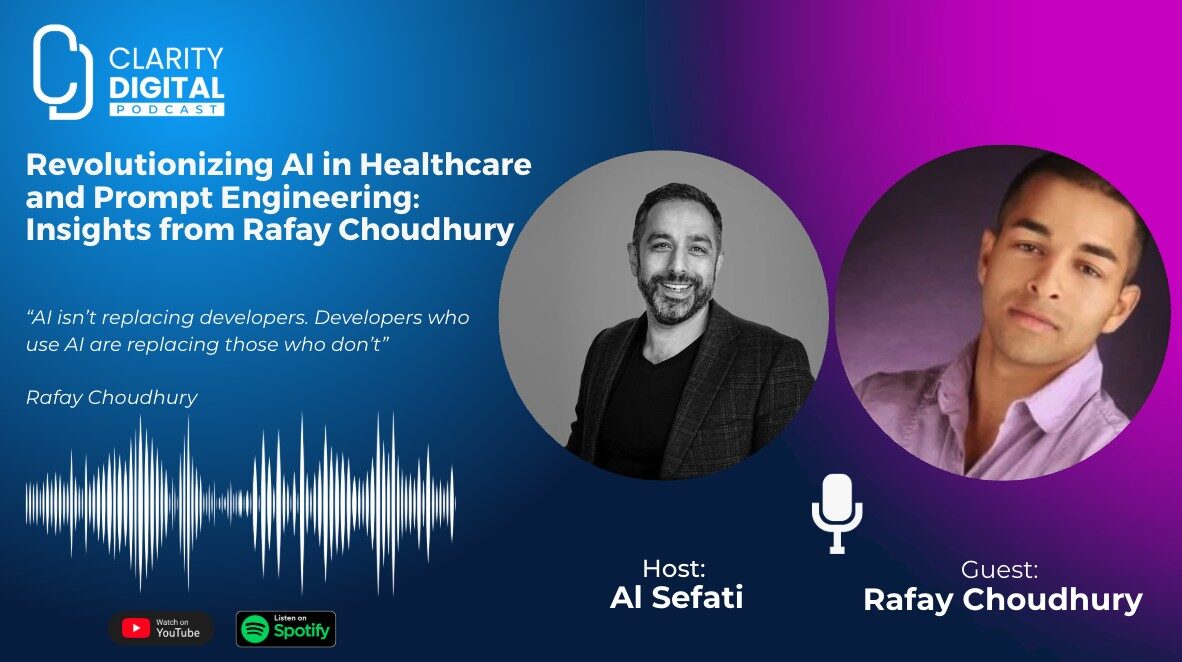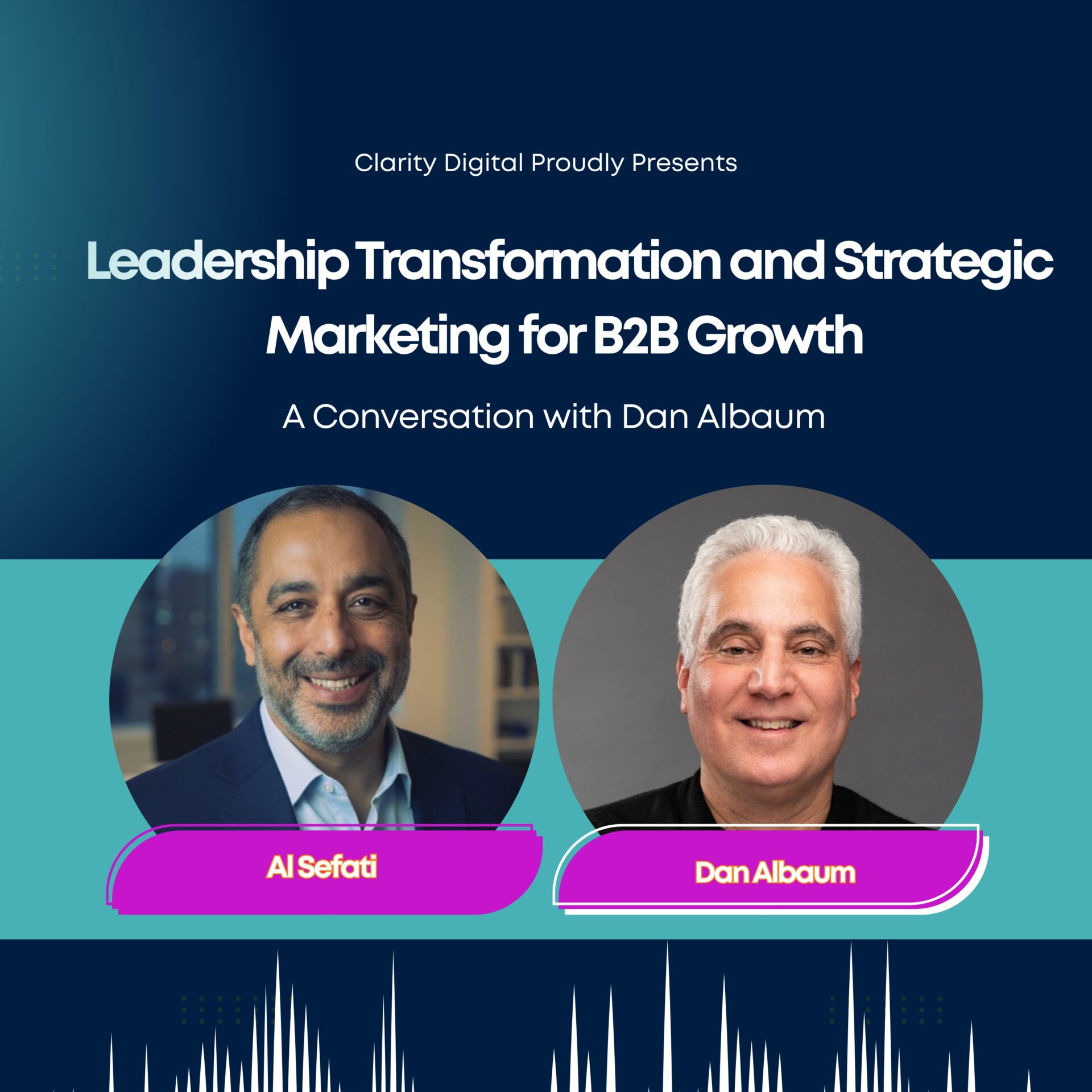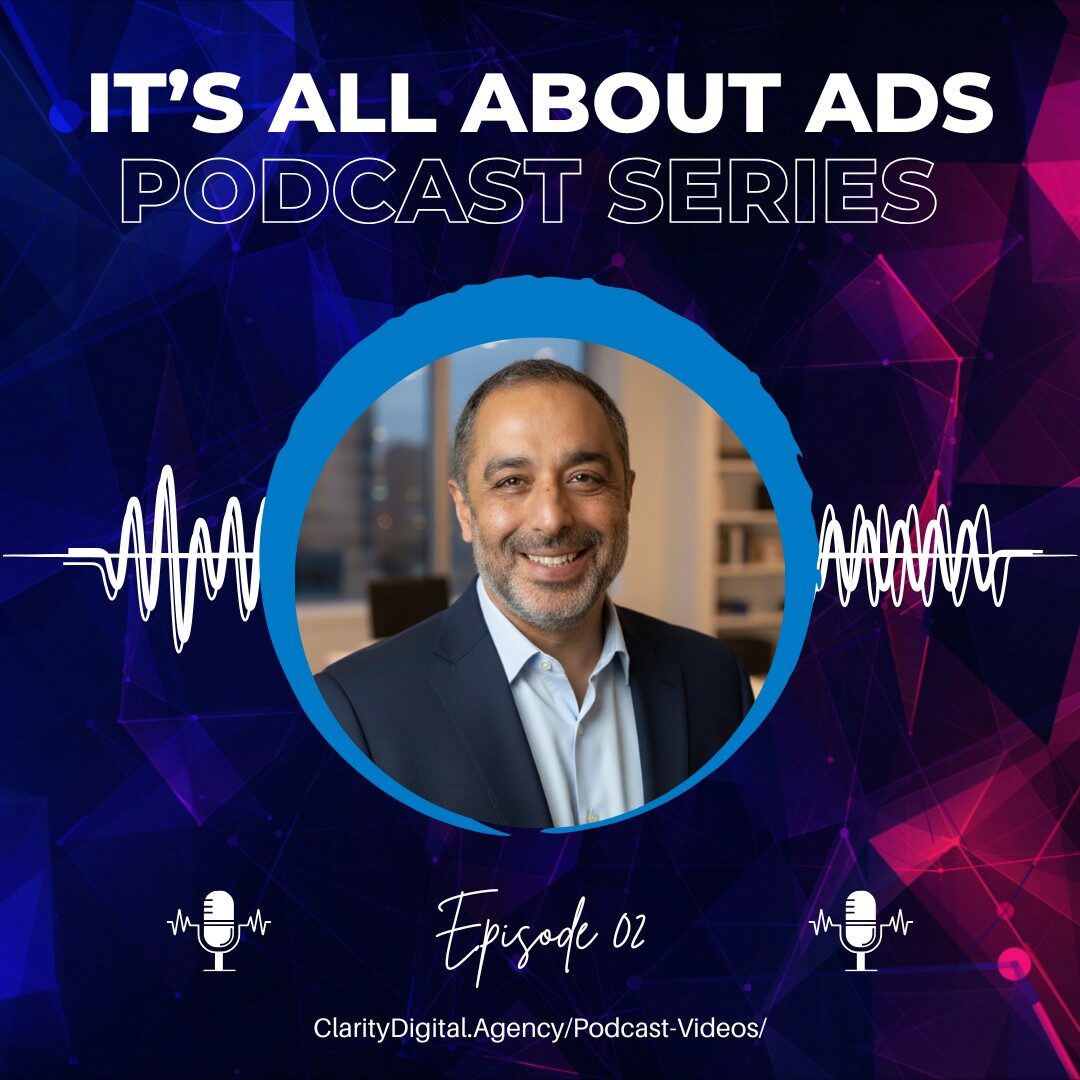In this episode of Clarity Digital Pod, host Al Sefati sits down with Rafay Choudhury, CTO of Blue and founder of Promptaa.com, for an eye-opening conversation about how AI is rapidly transforming healthcare, marketing, software development, and the job market itself. From custom-trained medical AI models to next-level prompt engineering, Rafay offers deep technical insights while staying grounded in real-world use cases.
AI in Healthcare: Beyond Hype, Real Impact
Rafay Choudhury leads engineering at Blue, an AI-first medtech company improving how healthcare providers operate. Their AI-driven systems streamline clinical workflows, saving time, reducing costs, and improving patient outcomes. One of their biggest success stories is with Ance (formerly Anthem), where they:
- Increased “discharge to home” rates by 82%
- Reduced patient harm events by 47%
- Saved over $1 billion
Rafay emphasized that their tech isn’t just about shiny demos—it’s about building reliable tools that free up providers to focus more on care and less on process.
How Blue Uses AI: RAG and Proprietary Models
Blue is currently leveraging OpenAI’s LLMs but uses retrieval-augmented generation (RAG) to significantly boost accuracy. RAG allows the model to pull in external, context-specific data during queries, resulting in more accurate and actionable responses.
While they wrap around OpenAI for now, Rafay revealed that Blue has trained three proprietary models and will start integrating them soon. These custom models are trained on highly domain-specific healthcare data, giving them a competitive edge in medical AI applications.
What Is RAG?
RAG, or Retrieval-Augmented Generation, enhances standard LLM behavior by enabling the AI to pull in relevant data from external sources at runtime. If you’re asking ChatGPT a question and it searches the web or internal documents to get more context—that’s RAG in action. Rafay explains it simply:
“Anytime a model goes out to grab external data to improve its response, that’s RAG.”
By combining the power of pre-trained language models with context-aware retrieval, companies like Blue are seeing far more accurate, trustworthy outputs.
Why Healthcare Is Behind—and How AI Can Help
Al pointed out how slow the healthcare industry has been in adopting digital transformation. Rafay agreed and attributed the lag to long procurement cycles and risk-averse decision-making. However, AI is helping the industry leapfrog forward. From remote robotic surgeries using HoloLens to AI-powered brain tumor detection, Rafay believes healthcare is on the brink of a major technological leap.
From Prompt to Product: Prompter AI and the Rise of Prompt Engineering
Rafay is also the creator of Prompter AI, a tool designed to help people create smarter, more structured prompts for large language models. Prompter turns basic instructions into well-structured XML templates—breaking them into key sections like:
- Objective
- Context
- Role
- Instructions
- Constraints
- Examples
This structured approach results in dramatically better outputs across ChatGPT, Claude, Gemini, and more.
He noted that XML structuring is already recommended by companies like Anthropic and Google, and it’s becoming the gold standard for serious AI users.
“English is now the highest-level programming language,” Rafay says. “Prompt engineering is how you talk to the machine.”
91% of Blue’s Code Is Written by AI
One of the biggest takeaways from the episode was this staggering stat: 91% of Blue’s production code is written by AI. Developers now focus on code review, security, and orchestration—not writing every line from scratch.
“AI isn’t replacing developers. Developers who use AI are replacing those who don’t!” Rafay notes—echoing a sentiment increasingly heard across industries.
The Shift in Consumer Behavior: AI Over Search Engines
With tools like ChatGPT, Claude, and Copilot becoming daily drivers for both business and consumers, Al asked Rafay whether AI will overtake traditional search engines. Rafay’s answer: Absolutely.
Just like Google replaced the Yellow Pages, AI assistants will replace Google for many queries. Why wade through pages of links when you can get a precise answer in one response?
This behavior shift will dramatically affect SEO, SEM, and content marketing, making prompt engineering, structured data, and model fine-tuning even more important.
Al’s Vision: Unified Analytics for Marketers
Al shared his concept for a new tool: a unified analytics platform that aggregates data from Google Analytics, SEMrush, Salesforce, and more—and lets marketers ask plain-English questions like, “Why were sales down last month?”
Rafay was fully on board with the idea, recommending backend API aggregation wrapped with AI agents for clean, simplified analysis.
“Your data is only as good as the questions you ask,” Al said. And AI can help both ask and answer those questions faster and more effectively.
The Future Is Agent Orchestration
Rafay believes the next frontier in AI isn’t just building smarter agents—it’s orchestrating them. Imagine multiple AI agents working together autonomously: one pulls in data, another analyzes, a third generates a report. The only thing missing is the human to validate the final output.
Blue already uses two agents—one for provider documentation workflows and another for general medical Q&A. But the roadmap is clear: more agents, more autonomy, better orchestration.
Music, Hobbies, and a Human Touch
Outside of AI and startups, Rafay is an accomplished musician. He writes and produces his own music—and recently used Suno AI to generate custom tracks for his kids, blending traditional songwriting with next-gen production.
“Back in the day, producing a song took hours of studio work. Now, you write your lyrics and Suno does the rest.”
He also loves Indian and Mexican food, especially tacos and dosas, and spent years living in Los Angeles before moving to Atlanta.
When asked what superhero he’d be, Rafay chose Iron Man—a natural choice for a technologist who builds real-world tools that once lived only in fiction.
This episode makes one thing crystal clear: the age of AI isn’t coming—it’s already here. Whether you’re in healthcare, software, marketing, or content, learning how to use AI is now non-negotiable. Rafay Choudhury is living proof of what’s possible when you combine deep technical knowledge with entrepreneurial execution.
If you’re a developer, marketer, or business leader, this episode is your wake-up call. Learn the tools. Master prompt engineering. Build for the future—or risk being left behind.




